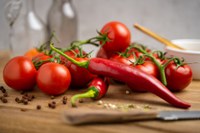Prairie Fare: Extend Your Enjoyment of Gardening This Season
(Click an image below to view a high-resolution image that can be downloaded)
By Julie Garden-Robinson, Food and Nutrition Specialist
NDSU Extension
“Well, Mom, you did it again,” my older daughter said.
I was not expecting a compliment was coming my way.
I was correct.
We were looking at our towering, bushy tomato plants in our raised garden beds. Some of the plants already were drooping with the fruits of the plants.
“One, two, three ...,” she counted.
“You can stop counting,” I noted. “We have 18 tomato plants.”
“I don’t like tomatoes,” she replied.
She actually eats tomatoes in many ways. I ignored the comment as I plucked weeds around my precious plants.
“If you see a weed, pull it,” she added in her best impression of me.
I glanced at her and smirked.
Why do my kids enjoy teasing me so much?
I didn’t tell my daughter that I have several tomato plants growing amid the potato plants. These extra plants came up by themselves, probably carried by birds or squirrels. That brings my total to 24 tomato plants in a fairly condensed space.
I will be following my own advice gleaned from the U.S. Department of Agriculture as I can tomatoes and salsa later this summer and fall. Freezing tomatoes or salsa does not require added acid such as vinegar, bottled lemon juice or citric acid.
Tomato varieties vary in their acidity. To reach a safe acidity (or pH) level for preservation in glass jars, home-canned tomatoes and salsa should be acidified with lemon juice or citric acid before canning.
To ensure safe acidity in whole, crushed or juiced tomatoes, add 2 tablespoons of bottled lemon juice or 1/2 teaspoon of citric acid per quart of tomatoes. For pints, use 1 tablespoon of bottled lemon juice or 1/4 teaspoon of citric acid.
Acid can be added directly to the jars before filling with product. Add sugar to offset the acidic taste, if desired. One to 2 teaspoons of sugar may be enough to enhance the flavor.
In home-canned foods, we are preventing the development of the potentially deadly botulism toxin with proper acidification. We also need to process the jars of tomatoes or salsa in a boiling water-bath canner for the recommended time.
Many vegetables require pressure canning.
My daughter and I checked the elevated box with sweet bell peppers and hot peppers. The raised bed includes a plant she purchased with her own money.
However, I have little use for “ghost” peppers in my recipes. They are extremely hot for my palate.
Peppers are in the capsicum family, and their flavor varies from mild to extremely spicy. Bell peppers lack the spicy properties from “capsaicin” found in their cousins, the jalapenos, habeneros and other hot peppers. This natural chemical was discovered in the late 1870s and is noted for the burning sensation it causes in mucous membranes.
Therefore, when handling hot peppers in food preparation, wear plastic gloves and avoid touching your eyes or face.
If you want to impress your friends, let them know that bell peppers have a ranking of “zero” Scoville heat units, while habanero peppers can have upwards of a 350,000 rating.
Like tomatoes, peppers are an excellent source of vitamin C and a variety of cancer-fighting antioxidants. Red bell peppers are among the best sources of vitamin C of any food source, and they are delicious on the grill this summer.
When possible, let your bell peppers mature to their beautiful shade of red. At the grocery store, you might notice that red bell peppers are more expensive than green peppers. They take up more space and time to care for, so they cost a little more.
Maybe someone has told you about “male” and “female” peppers, depending on the number of lobes or bumps on the base of the fruit. Bell peppers do not have a “gender” and different flavors depending on their number of bumps. Their flavor depends on their variety and degree of ripeness.
Watch what you learn on Facebook.
Whether you grow, buy or receive tomatoes from generous friends this year, see https://tinyurl.com/NDSUFoodPreservation for a wide range of canning information, including tomatoes and several types of salsa.
Try peppers in tasty homemade salsa, raw with a dip, grilled, stuffed, sauteed or pickled. If you like pickled peppers added to a sandwich, consider trying this recipe from the U.S. Department of Agriculture.
Pickled Hot Peppers
4 pounds hot long red, green or yellow peppers
3 pounds sweet red and green peppers, mixed
5 c. vinegar (5% acidity)
1 c. water
4 tsp. canning or pickling salt
2 Tbsp. sugar
2 cloves garlic
Wash peppers. If small peppers are left whole, slash two to four slits in each. Quarter large peppers. Blanch in boiling water or blister to peel. Peppers may be blistered using one of the following methods. Oven or broiler method: Place peppers in a hot oven (400 F) or broiler for six to eight minutes or until skins blister. Range-top method: Cover hot burner, either gas or electric, with heavy wire mesh. Place peppers on burner for several minutes until skins blister. Cool and peel off skin. Flatten small peppers. Fill pint or half-pint jars, leaving 1/2 inch head space. Combine and heat other ingredients to boiling and simmer 10 minutes. Remove garlic. Add hot pickling solution over peppers, leaving 1/2 inch head space. Process in a boiling water-bath canner for 10 minutes if at an altitude of zero to 1,000 feet, 15 minutes at an altitude of 1,001 to 6,000 feet or 20 minutes at an altitude of 6,000 feet. Makes about nine pints.
(Julie Garden-Robinson, Ph.D., R.D., L.R.D., is a North Dakota State University Extension food and nutrition specialist and professor in the Department of Health, Nutrition and Exercise Sciences. Follow her on Twitter @jgardenrobinson)
NDSU Agriculture Communication - July 16, 2020
| Source: | Julie Garden-Robinson, 701-231-7187, julie.garden-robinson@ndsu.edu |
|---|---|
| Editor: | Ellen Crawford, 701-231-5391, ellen.crawford@ndsu.edu |




